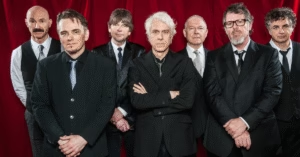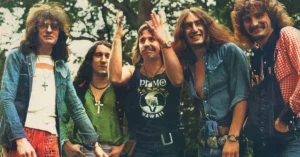Gong: Cosmic Mischief and Psychedelic Innovation
Gong. Origins in the Counterculture: Daevid Allen’s Vision
Gong was founded in 1967 by Daevid Allen, an Australian musician and poet who had previously been a founding member of Soft Machine, and Gilli Smyth, a British poet and performer. The band’s roots were planted in Paris, just before the revolutionary fervor of May 1968, which deeply shaped Gong’s anarchic and boundary-pushing spirit.
When Allen was denied re-entry into the UK due to visa issues, he remained in France and formed Gong—a band that would become one of the most imaginative, bizarre, and enduring groups in psychedelic and progressive rock.
Gong. Early Sound: Psychedelic Jazz and Experimental Roots
The debut album, “Magick Brother” (1969), was a lo-fi, free-spirited blend of psychedelia, jazz, and experimental poetry, laying the foundation for the more ambitious and surreal works that followed. With Gilli Smyth’s space whisper vocals and Allen’s quirky, high-pitched delivery, Gong began to forge a style that was unmistakably their own.
Gong. The Radio Gnome Invisible Trilogy: The Core of Gong’s Mythology
Gong’s most celebrated and influential period came with their Radio Gnome Invisible Trilogy—a trio of albums released between 1973 and 1974 that combined progressive rock, space jazz, satire, and a sprawling sci-fi mythology.
1. Flying Teapot (1973)
Introduces the Gong mythology: pot head pixies, octave doctors, and flying teapots—all part of a cosmic narrative that satirizes authority and celebrates spiritual freedom.
2. Angel’s Egg (1973)
Deepens the myth with more surreal imagery and sophisticated musicianship. Features classics like “Other Side of the Sky” and “Oily Way”. Gilli Smyth’s space whispers become a crucial textural element.
3. You (1974)
The musical high point of the trilogy. A fusion of ambient space rock, intense jazz improvisation, and psych-prog epics. Tracks like “Master Builder” and “The Isle of Everywhere” showcase the band’s musical precision and cosmic aspirations.
This trilogy featured a stellar lineup:
- Daevid Allen – vocals, guitar
- Gilli Smyth – vocals, space whispers
- Steve Hillage – guitar
- Tim Blake – synthesizers
- Pierre Moerlen – drums
- Mike Howlett – bass
- Didier Malherbe – sax, flute
This period defines Gong’s identity: a theatrical, hallucinatory blend of satire and spiritualism wrapped in otherworldly soundscapes.
A New Direction: Pierre Moerlen’s Gong
After Allen’s departure in 1975, percussionist Pierre Moerlen took over, steering the band into a jazz fusion direction. Albums like:
- “Gazeuse!” (1976, released as “Expresso” in the US)
- “Expresso II” (1978)
…featured dazzling vibraphone-driven instrumentals and a virtuoso approach. Though the whimsical mythology was gone, these records showcased serious musicianship and remain beloved in jazz-rock circles.
Gong. Reunions, Spinoffs, and Legacy Projects
Gong’s history is fragmented and multidimensional, with multiple incarnations and offshoots:
- Planet Gong (late 1970s) – A punk-infused version with Daevid Allen and members of Here & Now
- Mother Gong – Led by Gilli Smyth, focusing on more ambient and spoken word-driven performances
- New Gong projects with Allen returning periodically in the 1990s and 2000s
- Gong Maison and University of Errors – More experimental projects helmed by Allen
In 2012, Allen assembled a new generation of Gong musicians, including Kavus Torabi (of Cardiacs), continuing the spirit of musical exploration.
Gong. The Modern Era: Gong Without Allen
After Daevid Allen’s death in 2015, Gong continued with his blessing. The modern lineup, led by Kavus Torabi, released:
- “Rejoice! I’m Dead!” (2016)
- “The Universe Also Collapses” (2019)
- “Unending Ascending” (2023)
These albums retain the psychedelic energy, mythological leanings, and free-spirited experimentation that define Gong—while introducing a more contemporary sonic palette.
Gong’s Musical Style: Cosmic, Chaotic, and Free
Gong’s sound is hard to pin down, but defining traits include:
- Psychedelic textures
- Jazz-rock fusion improvisation
- Absurdist, sci-fi lyrics
- Spoken-word and “space whisper” vocals
- Use of synths, tape loops, and exotic instrumentation
Their music defies linear genre definitions. Gong is a blend of Zappa-esque absurdity, Miles Davis-inspired fusion, Canterbury gentleness, and countercultural rebellion.
Influence and Legacy
Gong’s influence runs deep:
- Central to the Canterbury Scene, alongside Soft Machine, Hatfield and the North, and Caravan
- Prefigured later psychedelic revival bands and experimental collectives
- Inspired ambient artists, krautrock fans, and jazz-rock musicians
- Helped define the space rock ethos alongside Hawkwind and Pink Floyd (in their more whimsical moments)
They are not just a band, but a mythos, an art project, and a countercultural movement that has inspired legions of underground musicians.
Final Thoughts: Gong as a State of Mind
To listen to Gong is to surrender to the absurd, to embrace complexity with a smile, and to recognize that music can be a vehicle for both escape and transformation. Whether you’re chasing the mystical flying teapot or basking in the grooves of jazz fusion, Gong remains a one-of-a-kind musical universe.





